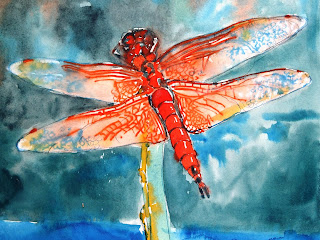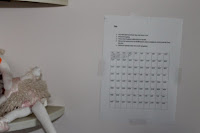Book Length Project Group member, Pat Johnson has written a series of fairy stories or allegories collected under the title: "Tales from the Dark Mountain".
The Coffee Bean Babies was an earlier story posted on this blog. There is an open-endedness to these stories that encourages the reader's active imaginative engagement. Hope you enjoy this new one from Pat.
The
Mountain Spring
Far away on the other side of the
world a village rests on the face of a
dark mountain. Early every morning when the villagers awake from their night
time dreams they hurry out into the sunlight. Dressed for a day of work, they
walk together down the mountain.
Today they have
a lot of work to do because their whole village is lying on its’ side and all
of the villagers want to rebuild their homes and their barns. They begin to
hammer and saw, when from deep beneath their feet they hear a great rumble from
inside the mountain. They stop their work to listen and they hear it again and
again; three times it resonates like sound made by a big bass drum. Then there is a great hiss like a snake and a
geyser of water suddenly shoots into the air.
At first the villagers think that this is widecrazity. Why was
a geyser in the middle of their village? Then they wonder if they are working
in a spot which the mountain wants for something else. After all the village is
not where it used to be. The explosion of the mountain moved it to a different
location. They decide that they must
move, so they begin to think about where they should go. Where is another good spot to build, to live?
Suddenly they notice that the geyser is forming a pool of
water around itself. The villagers hurry to collect their children, their beds,
pots and tools before they are submerged! Then they taste the water and find
that it is delicious, cold and refreshing. So they decide not to move too far
away from the delicious water; they go
just a little way up the mountain and begin to build there.
The villagers spend their time drinking the water and working
on their homes. All the men and all the women have come to love the fresh
spring water. They drink it every day and everyday they grow a little bigger.
Soon they are so fat and so round that they look like a bunch of balloons
bouncing around on two string legs.
They children do not find the water delicious. They have not
been drinking so much of the water as the grown-ups and they have not become
large like them. They do not like the way the adults have changed and become
fat and bouncy. They are beginning to be afraid of their parents, afraid of all
the adults, and afraid of the water. They decide they will only drink the water
from the stream - the stream where they always got their water before and where
they have always done their washing.
As the days go by, the adults stop working. Instead they lie
down and roll about at the edges of the spring. They love to watch as the water
changes colour through the day – pale gold in the early morning, red like blood
when the sun blazes at noon, cool blues and greens in the late afternoon, and
black as coal at dusk. They are enamoured of the water. They drink it and bathe
in it and carry it carefully to their half-built homes. They cannot bear to
leave the pool for more than a few
minutes. They are besotted. All they want to do is loll in the wonderful water.
This makes the children very unhappy; their parents are not
interested in them anymore. All they care about is their new and wonderful
water. The children are wary. They keep a careful watch on the adults and a
careful eye on the spring but they do not know what they are looking for.
The children continue to get their own water from the stream,
avoiding any red flowers, and bringing the chickens, the pigs and cows and
horses to the stream to drink. The children do not trust the new spring. They
do not trust its deliciousness or its changing colours. They are worried but
they are powerless to do anything against the big adults who do not listen.
One day they are watching as the villagers as usual are
lounging around the spring, admiring it, trailing their hands in it and
drinking it in little sips so that it
will last all day. Their string legs have filled out and are as fat as the rest
of them.
Some of them are dancing in the water when the children
notice that they can see straight through them. They have drunk so much that
now they are just made of water. Their skin, like balloon skin, is transparent
and they can see the water sloshing around inside. This scares the children but
it only makes the adults laugh and laugh. They shake and giggle and roar with
laughter. Soon they are all in the pool of water dancing and looking though
their skins, fascinated by the water sloshing around in their bodies.
The children watch, very upset, but they don’t know what to
do. Then they hear a loud ‘POP!’; one of the biggest roundest adults has split
his skin and his water has run right out of him into the pool. This only makes
the other grown-ups laugh harder and louder. ‘POP!POP!POP!’ They are all
bursting and disintegrating, all their water is filling the pool. It is
overflowing and spilling down the mountainside.
The children are horrified.
The adults have gone to water. The little children are crying and holding tight
to their older brothers and sisters. They watch as the water flows all the way
down the mountain to the floor of the valley below. They race down the mountain
to look for their parents, to see what will happen.
Down in the valley, the water is bubbling and rushing. The
children can see watery arms and legs rising to the surface and rolling under
again. Some faces pop up like corks that have been held under. The adults are reforming.
Their parts are coming together and firming up. One by one, they stand up and
walk toward the waiting children. They pick up their children and hug them.
They shake their heads wonderingly and
the last drops of water flick off their
hair. The children hold their parents tight, feeling their solid bodies.
Together, they walk back up the mountain and when they reach
the place where the spring should be, it is no longer there. It is as if it never
was. The water has all gone. There is grass interspersed with fine yellow daisies
where the spring used to be, but they are too dazed to notice.
The villagers act mechanically; they take the chickens and
the cows and the pigs and horses and put them in the barns. The adults don’t
really understand what happened to them. So they talk together and decide it is
time to go deep into the mountain because there they will be safe. Once they have made this plan they feel much
better, and they gather up their children, ready to go.
They travel far into the heart of the mountain. When they
have gone far enough they lay down and cover themselves in furs and go to sleep
deep in the earth where it is dark and quiet. They sleep for years as the
seasons come and go. They are part of the mountain that does not change. And as
they sleep they grow strong from the ancient truth of the mountain.



















